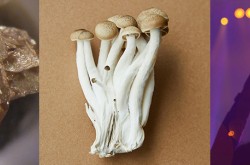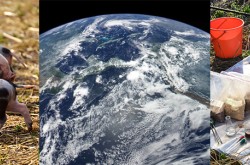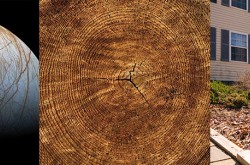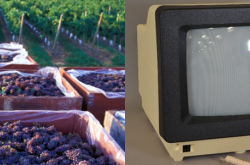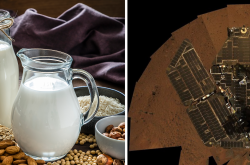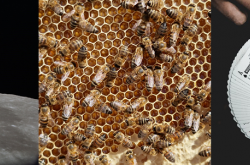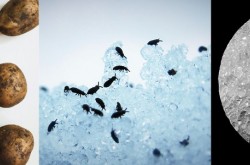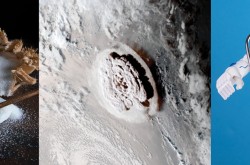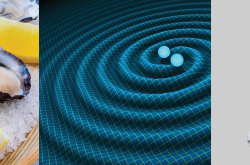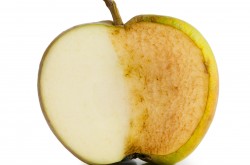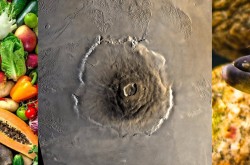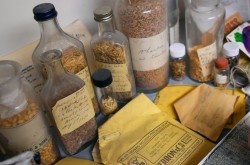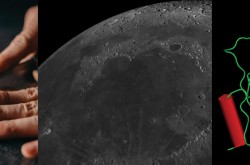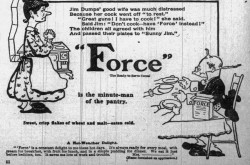3 things you should know about the science of making delectable chocolate, how fevers help fight infections, and how Canadian scientists are studying material from the asteroid Bennu

Meet Renée-Claude Goulet, Cassandra Marion, and Michelle Campbell Mekarski.
They are Ingenium’s science advisors, providing expert scientific advice on key subjects relating to the Canada Agriculture and Food Museum, the Canada Aviation and Space Museum, and the Canada Science and Technology Museum.
In this colourful monthly blog series, Ingenium’s science advisors offer up three quirky nuggets related to their areas of expertise. For the March edition, they tell us how making appetizing chocolate is a delicate engineering feat, how Canadian scientists have the opportunity to study asteroid material returned from Bennu, and how a fever is a sign your body is battling infection and boosting your immune system.
The delicate dance of chocolate: Why your accidentally-melted treat lost its magic

Chocolate has a short shelf life because its microscopic structure transforms over time. Old chocolate starts to change colour and develops a hard, grainy texture.
Ever accidentally melt chocolate in a pocket or hot car, and thought it would re-solidify perfectly? But when you finally tried it, it was dull, soft, grainy, and didn’t melt in your mouth? Why did your chocolate turn from a nice tasty treat into something so different? It’s because chocolate is a delicate engineering feat, and the processes to make it aren't easily reversible.
It took millennia, starting with the domestication of the cacao tree, to develop chocolate into what it is today. Chocolate is the result of people constantly experimenting and studying the methods to make it, and improving on them with new processes and technologies. In fact, chocolatiers have some highly scientific methods to get chocolate to perfection!
Chocolate is mainly cocoa fat from the fermented, dried, and processed cocoa bean, with added milk, sugars, and emulsifiers (substances that help the fat stay mixed with the other ingredients). There are no chemical changes when chocolate switches from liquid to solid and back, only a different arrangement of molecules. What makes or breaks chocolate is what happens while the liquid fat cools and reassembles into a solid.
When fat cools it starts to make tiny crystal shapes, and other fat molecules align along these crystal “seeds” and grow a larger crystal structure. Similar to how gems form when molten rock cools, or when water freezes. A ton of factors affect the shape these crystals take. The scientific terms for this is polymorphism.
Cocoa fat can assemble in six different forms, and only one of the forms – form 5 – makes chocolate snap when you bite it, glossy, and melt in your mouth. Forms 1 to 4 make chocolate soft, granular, and not melt properly in your mouth. This is because in these four structures, the fat molecules are loosely packed and have air spaces between them. In shape 5, the fat layers are densely packed, which gives chocolate its desired properties.
Without careful control, cocoa fat in chocolate will reassemble in the same batch into a mixture of five different shapes, when really, we want only one of them! So in comes a process called tempering.
People long ago discovered that to get the fat crystal form we want, chocolate needs to be heated to a specific temperature, then slowly cooled, and then heated once more before a final cooling. The temperature and duration at every step are crucial to getting a desired product.
Once chocolate has settled into form 5, and after a few months on the shelf, it will convert to the sixth form, which is very hard and has a higher melting point; it also loses its sheen. This is a good excuse to not hang on to chocolate too long and to eat it right away! One way to preserve the shelf life of chocolate is by keeping it in cool temperatures, which will slow down the conversion from one crystal form to another.
Since tempering is a long, delicate, and multi-step process, ongoing research seeks alternative methods to achieve the ideal fat crystallization. One of these ways is through sonication. By applying sound-produced tiny vibrations to chocolate as it cools, researchers were able to assist the fat molecules in aligning in just the right way. Another method is by seeding the cooling mixture with pre-formed crystals from "ideal" chocolate. This gives cooling fats a structure to solidify onto, instead of waiting for natural "seed" crystals to form to kick off the crystallization process.
So, this is why we get subpar results when we try to salvage accidentally-melted chocolate: because our imprecisely melted and re-solidified chocolate didn’t go through the tempering process again and we end up with chocolate containing a mix of the different forms of fat crystals! The more you know!
By Renée-Claude Goulet
OSIRIS-REx returned record amount of asteroid material
The sample capsule returned to Earth by the OSIRIS-REx mission contained an impressive total of 121.6 g of rock and dust from the asteroid Bennu. This quantity not only sets a record as the largest amount ever sampled from an asteroid, it surpasses the original mission target of 60 g by double. The sample returned to Earth in September 2023 and was immediately retrieved from the Utah desert, but disassembly of the capsule was impeded at first by two stubborn fasteners.
Launched in 2016, the OSIRIS-REx successfully completed its mission to rendezvous with, map, analyze, and sample the asteroid Bennu. It spent two years in orbit around the asteroid before selecting a target for sampling. Initially, there was an educated interpretation that Bennu would feature some sandy to gravelly regions convenient for sampling, but as the imagery improved on approach, it became evident that the terrain was more challenging, characterized by a rugged landscape dominated by boulders.
After careful consideration, the sampling site Nightingale was chosen because it offered a small region of finer material of high scientific value. The Touch-and-Go Sample Acquisition Mechanism (TAGSAM) worked wonderfully in the end, making quite the impact on Bennu’s surface, though there was fear the sample collecting mechanism wouldn’t close because it collected more than expected.
The selection of the approximately 500-metre-wide Near-Earth Asteroid (NEO) Bennu was based on several considerations. Being an NEO, it is in close proximity to Earth, allowing a relatively swift two-year journey to reach it. Beyond its accessibility, Bennu holds special significance as it encapsulates well-preserved, unaltered material from the early solar system. Remarkably, some of the dust grains found on Bennu might even predate our solar system. Data from both terrestrial telescopes and spectrometers onboard the OSIRIS-REx spacecraft have confirmed Bennu's carbon-rich composition, suggesting it could provide insights into the origins of life, including the delivery of life-forming compounds to Earth. On top of which, studying Bennu contributes to our understanding of asteroids that potentially threaten Earth, encompassing their trajectory, how they move in their orbit and what the environment is like on their surface.
Canada played a key role in this mission as we contributed the OSIRIS-REx Laser Altimeter instrument that uses a laser to measure distances. OLA scanned the entire surface of Bennu, and created an exceptional 3D model of the asteroid combined with imagery collected from the spacecraft’s cameras. OLA also provided information about the surface features such as the shape and distribution of boulders, which assisted in sample site selection.

OSIRIS-REx astromaterial processors prepare to remove material from the capsule into sample trays.
NASA's Johnson Space Center will first preserve and curate the samples, with portions allocated for scientists in the US, Canada (4%), and Japan. A global sample catalogue will then be released for scientists worldwide to request material for study, fostering collaborative exploration of Bennu's properties and contributing to unravelling the history of the early solar system.
After OSIRIS-REx delivered its precious sample capsule to Earth, the spacecraft was given a new mission and a new name, OSIRIS-Apophis Explorer. In a continuing pursuit of understanding the small bodies in our solar system, OSIRIS-Apophis Explorer is now on its way to study another NEO, Apophis, a 365-metre-wide stony asteroid.
GO FURTHER
Watch the live recording of OSIRIS-Rex sampling Bennu
By Cassandra Marion
Fevers: your body’s hottest defence against infection
Winter may bring us the joys of snow sports and hot drinks, but it also brings the inevitable onslaught of illnesses. From the flu and common cold, to COVID and strep throat, our bodies are constantly fighting off invading germs.
Luckily for us, our bodies have a huge variety of defences to detect, prevent, and fight off these tiny invaders. This sophisticated system of defences – our immune system – is as variable and complex as the pathogens that it defends against. Fevers are one important tool in our immune arsenal.

Reading above 38°C on the thermometer? Looks like you have a fever.
Fevers are most common when our body is fighting an infection. When pathogens threaten to overwhelm our initial immune response, our body sends a signal to the hypothalamus. The hypothalamus is a region of the brain that acts like our personal thermostat. When our hypothalamus gets that signal, it increases the number on the thermostat by a couple degrees.
In response, our bodies experience some changes. We start to shiver to generate heat, our heart rate goes up, and the blood vessels in our arms and legs constrict to send all that warm blood to our core. We feel cold and instinctively seek out all the cozy things: pajamas, blankets, hot liquids, and our bed. All that helps our body temperature rise.
The resulting high temperature serves several purposes: it damages pathogens, stimulates certain parts of our immune system, makes our cells more active so that they can heal faster, and tells our liver and spleen to hold onto certain ions like iron and zinc to limit bacterial growth.
Once the infection is under control, the hypothalamus decides to go back down to normal. Our body responds by making some changes to help ‘break’ the fever and cool off. We sweat, the blood flow to our arms and legs increases to help release heat from our core, and we throw off our blankets.
It is interesting that some of the symptoms we associate with illness are actually signs that our bodies have things under control, and that we’re finally on the mend. In any case, whenever you’re feeling sick, it’s important to rest and stay hydrated so that your immune system can do its job.
Disclaimer: This article is for educational purposes only and should not be regarded as medical advice or replace the advice of your physician.
By Michelle Campbell Mekarski
Enjoying the Ingenium Channel? Help us improve your experience with a short survey!







